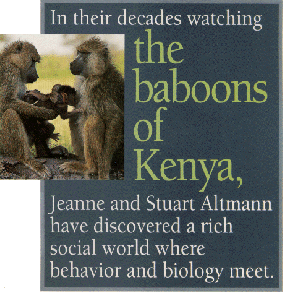
 The University of Chicago Magazine August 1995
The University of Chicago Magazine August 1995

STUART ALTMANN DIDN'T SEE what started the fight. But there it was, the male baboon, fearsome with his daggerlike canines, menacing a female half his size. The male chased the female around the savanna and up a nearby acacia tree, until she hung high up on branches barely able to support her weight. The attacker kept up his threats from a nearby limb while the other baboons in the group ignored the scene--all but one adult female, who ran to the tree's base and started screaming at the male.
Why did this one animal come to the rescue? To Altmann, who with his wife and fellow researcher, Jeanne, PhD'79, has been studying the baboons of Kenya's Amboseli National Park since 1963, the answer was obvious: The female under attack was her daughter.
He tells the story to show how even the baboons' most basic behaviors would be mystifying without being able to recognize individual animals and knowing which is related to which. Those methods, rare when the Altmanns first came to Kenya but now standard procedure in studies of wild primates, are typical of the many advances they've helped bring about. While the average primate study lasts, by one estimate, just 18 months, the Altmanns, through intense, long-term observation, have untangled the meaning of behaviors more complex--and more variable among individuals--than brief studies could ever reveal.
Along the way, the two U of C professors of ecology and evolution put the lie to an earlier picture of baboons. Other researchers had focused on the males' ongoing battles for dominance and mating opportunities. "The ladies and the babies were just there as also-rans in the story," recalls Stuart Altmann. "They were what the males were fighting over."
But the Altmanns have shown that the world of baboons--which are among the most adaptable of non-human primates, living in environments from semi-desert to forest --centers on females and kinship, not males and fighting. Females, too, have a dominance hierarchy, with daughters inheriting their mother's rank in a fairly strict fashion. While males migrate from one group of animals to another--literally clawing their way up and down the social ladder--females stay with their mother's group their whole lives, making the female hierarchy and kinship bonds the stable core of each group's social structure.
Early work on wild primates viewed animals in age-sex classes like adult males, juvenile males, adult females, or juvenile females. The Altmanns' subjects--currently over 300 yellow baboons living in more than six groups in Amboseli, in the shadow of Mount Kilimanjaro--get logged into journals and charts by name: Alto, Ozzie, Scar, and so on.
This personal approach reflects the Altmanns' interest in individual variation. In a striking example of that variation, Jeanne Altmann showed how mothers' parenting skills--previously seen as innate behaviors--vary widely with dominance rank. Low-status mothers, for example, are more protective of their offspring. They're also far more likely to give birth to sons--an adaptation that, while mysterious in its mechanism, makes sense, given that a daughter would be stuck with her mother's lesser rank.
Such findings have an impact beyond primatology. In the face of today's reductionist trend in biology that looks to genetic explanations for behavior, they show how social factors can affect individuals' actions and even physiology. Moving into its third decade, the Altmanns' work--doubly unusual, both as a husband-wife collaboration and in its long-term nature--continues to surprise.
CONTINUE READING "THE BABOONS OF KENYA"